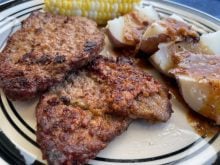Traditionally in this column we have had a Christmas cookbook draw. In planning for this year’s draw, we thought it would be fun to ask readers to reflect on one of the most memorable gifts they have
received.
For prizes, the Western Producer is donating a metal cooler and 10 beverage containers. Dorothy Long of Canolainfo is donating canola-made soaps, spa kits, and canola cookbooks. Atco is supplying cookbooks, including a 2006 Holiday Collection with recipes
such as the one below.
To enter the draw, send your name, address and description of your most memorable gift to: Memorable Gifts, c/o TEAM Resources, The Western Producer, Box 2500, Saskatoon, Sask., S7K 2C4 or e-mail to team@producer.com. The draws will be made on Dec. 4.
Read Also

AgriStability updates offer stronger support for farmers
One of the most significant updates to the AgriStability program for the 2025 program year is the increase in the compensation rate.
We will share some of your stories in our December columns.
Holiday fizz
4 cups cranberry 1 L
cocktail, chilled
1 cup orange juice, 250 mL
chilled
1 cup grapefruit juice, 250 mL
chilled
2 cups ginger ale, 500 mL
chilled
Combine all ingredients except ginger ale in a large pitcher. Stir in ginger ale, to taste. Serve immediately. Makes eight cups (two L).
Source: A Holiday Collection, Atco Blue Flame Kitchen, 2006, Edmonton, Alta., www.atcoblueflamekitchen.com.
Solutions and substitutions
A good gift is a Centax book called Solutions and Substitutions written by Manitoba home economist Reena Nerbas.
She has written this book about easy stress-reducing quick fixes for the kitchen, bathroom, bedroom, laundry and stains, garage and garden.
It sells for $14.95 plus $4 postage and handling (in U.S. and Canada) plus GST.
Contact: Reena Nerbas, Box 429, Blumenort, Man., R0A 0C0 or e-mail: rnerbas@mts.net.
The following is an example of her herb suggestions for salt substitutions in recipes, especially our winter soups and stews:
Herb flavours
Basil brings out flavour in tomato dishes.
Bay leaf enhances stews.
Chives for soups and salads.
Cinnamon for baking, desserts and drinks.
Cloves are great in meat and vegetable dishes and soups.
Cumin for an earthy flavor in marinades, rice, chili and tomato sauce.
Curry adds heat and flavour to rice, chicken, fish and vegetables.
Dill in sandwiches, salads and soups.
Ginger gives zest to meat and baking.
Garlic salt for soups, stews, potatoes and rice.
Marjoram for meat, fish and vegetable dishes.
Mustard enhances breads, salads, stews and marinades.
Onion keeps soups and casseroles from tasting bland.
Paprika is the finishing touch to potatoes, chicken and fish.
Parsley adds to soups or sandwiches.
Rosemary and sage for meat, poultry or fish.
Better gift wrapping
- Bring wrinkled gift wrap back to life by spraying the back of the paper with starch and then ironing on low heat.
- Buy a few rolls of solid-coloured glossy gift wrap after Christmas on sale, and use it to wrap beautiful presents for other occasions through the year.
- Wrap a gift in velvet and top with a single rose. When giving a bottle of wine, stand it inside a glass vase and surround it with small decorative stones. Fill a watering can with seeds and small garden tools, and top with a ribbon. Fill a whimsical ceramic mug with golf tees, enclose in cellophane.
- Wrap your gift in a small pillowcase. Tuck the gift inside and fill the pillowcase with tissue paper. Tie a ribbon, a soother, a garter or a photograph, depending on the occasion.
- To disguise the contents of a gift, add jellybeans, nuts, shells or macaroni in a box inside another box.
- Use popcorn or crushed newspaper inside a package instead of Styrofoam.
- Wrap gifts to set the stage for what is inside the package. Use sheet music, towels, scarves, brown paper bags, newspaper or a map.
- To send cookies off to a loved one away from home, stack them on top of each other in a potato chip tube container.
- To send a document, watercolour or drawing to someone, wrap it around an empty foil or waxed paper roll, then put the tube into the original box, wrap and send.
- To tie a package tightly before mailing, moisten the string before tying.
- Substitutes for store-bought bows include pom-poms, stickers, balloons, pine cones, silk flowers, rolls of candy, toy cars, wooden spoons, pennies, photo frames, candles, photos, postcards, baby rattles or small tools.
- Cut up old greeting cards to make gift tags or make computerized labels.
- To avoid confusion at showers, weddings, Christmas or children’s birthday parties, tuck a card inside the package, as well as outside.
- A novel idea for sending gift money is to put the money inside a deflated balloon, and the child will inflate the balloon, and pop it to get the money.
Educating children
Another interesting book that I have recently read is Is Your Child’s Brain Starving? by Dr. Michael Lyon and Dr. G. Christine Laurell, Mind Publishing Inc., 2002.
I enjoyed reading it, in spite of the strong marketing component for products they believe in. I liked that it reinforced what I already know about the importance of nutrition in our children’s diets.
It was particularly interesting to me, since it coincides with a class that I am taking. We are studying the brain, the nervous system and how what we ingest through nutrition and prescription drugs affects our health and welfare.
Lyon writes that as a research scientist and medical doctor, he has witnessed the transformational power of good nutrition in people’s lives. Nutritious food is available to us; we just need to make appropriate choices.
As well as recipes, Lyon and Laurell leave us with some nutrition tips:
- Recent research in 2000 shows that eating fresh produce has declined in North America. We know that the more frequently children are exposed to fruit and vegetables, the more likely they will start eating and enjoying healthy food. So continue to put the broccoli and carrots on the dinner table and your kids will eventually eat them. Choose organically grown foods as often as possible.
- To get more omega 3 fats in your diet, try adding flaxseed oil to salads, vegetables or other food. You can also add wild salmon or sardines at least twice per week.
- Avoid packaged, so-called convenience foods that are damaging to our brain chemistry. They contain too much saturated fat, sugar and sodium. Symptoms of these excesses are irritability, restlessness and lethargy. Also try to reduce your use of ketchup and mayonnaise.
- Consider using honey rather than sugar as a sweetener, when appropriate. Encourage water drinking rather than soft drinks. About 40 percent of a teenager’s sugar intake comes from soft drinks.
- Save steamed vegetable and potato water and freeze it to make stews and soups.
- Toast nuts and seeds to toss on salads for extra flavour, nutrition and crunch.
Acknowledging that we do still want treats, try using your imagination to make treats like this one below:
Fruit pickups
1 whole fresh pineapple or
honeydew melon
1 cup honey 250 mL
1 cup sesame seeds 250 mL
and/or short, shredded
desiccated coconut
Pare and core the pineapple.
Cut it into pieces about two inches (five cm) square. Insert a toothpick into each square.
Warm the honey in a saucepan. Do not boil. Dip the pineapple squares into the honey and roll them in seeds. If desired, put them in the freezer to harden.
For the melon: Use a melon baller to make little balls that can be dipped in the warm honey and rolled in seeds or coconut.
Serves 8-9 people.
Barbara Sanderson is a home economist from Rosetown, Sask., and one of four columnists comprising Team Resources. Send correspondence in care of this newspaper, Box 2500, Saskatoon, Sask., S7K 2C4 or contact them at team@producer.com.














